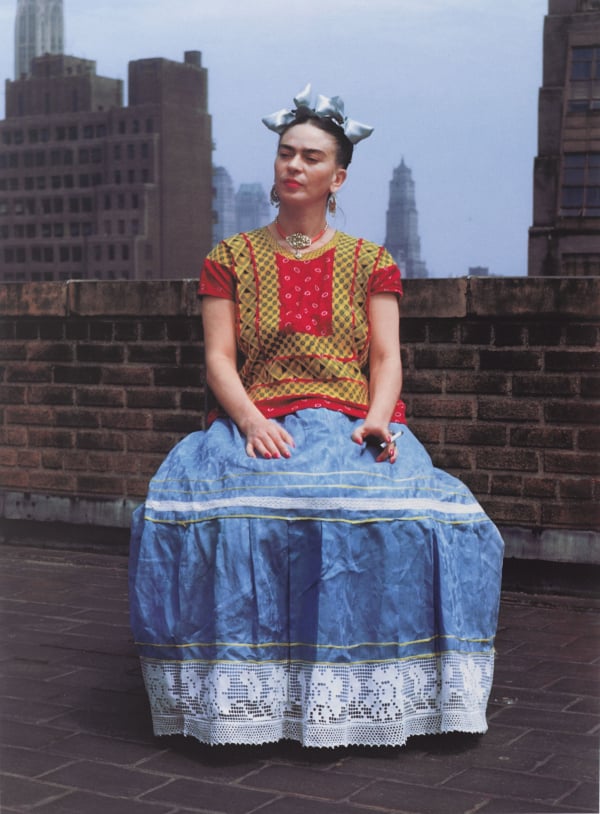
In November 1931, Frida Kahlo and her husband Diego Rivera traveled to New York for the opening of Rivera’s exhibition at the Museum of Modern Art. The following excerpt from the book Frida in America: The Creative Awakening of a Great Artist recounts the artist’s experience in the American city.
While in New York, [Frida Kahlo] experienced the huge disparity between the wealthy and the poor.
On the one hand, in her short time in this city she’d been surrounded by millionaires, socializing in their spacious homes, partaking of food and drink served by the hired help. On the other hand, she told her mother: “Witnessing the horrible poverty here and the millions of people who have no work, food, or home, who are cold and have no hope in this country of scumbag millionaires, who greedily grab everything, has profoundly shocked [us].” Frida and Diego even visited a homeless shelter, where they saw people “sleep like dogs in a pen.” The experience inspired Diego to portray this grim reality in a painting called Frozen Assets, where bodies are placed side by side as if in a morgue, hidden away beneath the cranes of industry.
What Diego’s painting doesn’t show is the dearth of shelters for the large numbers of people in need—1.2 million people across the country had lost their homes in the first few years of the Depression. In New York, roughly 2,000 homeless people wandered the streets.
For some New Yorkers, the only way to survive was to build their own shacks out of wood or bricks. Soon encampments began popping up in various parts of the city. The most notorious was known as “Hoover Valley,” named after President Herbert Hoover. This shantytown, comprising seventeen shacks, was set up in Central Park north of Belvedere Castle in the area known today as the Great Lawn. Although the unemployed men in Hoover Valley had been arrested in July 1931, by wintertime even the wealthy residents of the new Fifth Avenue and Central Park West apartments didn’t protest when the men returned. As weather conditions and the economy deteriorated, a modicum of sympathy appeared among the affluent. But Frida didn’t hear much of it from the well-to-do people with whom she interacted. And even Diego, she told her mother, had started to “hate this country a little.”
Although the apparent contradictions between Diego’s attitudes about the rich and his behavior toward his capitalist patrons didn’t seem to bother him, the issue weighed on Frida’s mind: “Unfortunately, he has to work for these filthy rich asses.” And she acknowledged, “I have no choice but to put up with them since they are the ones who buy paintings.”
The cover of Frida in America (2020) by Celia Stahr.
Frida felt more at home surrounded by art. Within the first week of exploring this “huge” city that seemed as if it could swallow her up, she found her way to the Metropolitan Museum of Art, located on Fifth Avenue at East 82nd Street. She was immediately drawn to the Egyptian section, with its re-creation of a tomb “brought from Egypt stone by stone,” some bas-reliefs, “magnificent sculptures from 4,000 and 6,000 years before Christ,” household objects, and costumes, she wrote. She also marveled at the “Greek archaic period, 3,000 years before Christ,” and the “Christian, Roman, and Etruscan art.” She told her mother that she found “very good copies of the mosaics from St. Mark’s in Venice” and saw some of the best art from the Medieval and Renaissance periods, as well as “originals by the Italian Primitive painters, German painters, and French Modern painters.” She enthused: “It’s very interesting and one can learn a lot of new things.” Frida was also thrilled to see some original Goya paintings—“You have no idea how he painted.” She spent hours exploring the museum, her energy never waning.
Frida was spellbound when she came upon El Greco’s View of Toledo. This oil-on-canvas landscape, which foregrounds green rolling hills and a small lake, pulls the eye up to meandering hills topped with gray-blue buildings, ultimately leading the viewer to a dynamic blue, gray, and white sky. It’s a typical El Greco sky, filled with jagged, apparitionlike light and dark clouds, a quality Frida would draw on in later paintings such as The Two Fridas (1939). She found the colors “the most wonderful” she’d ever seen. El Greco had painted his feeling of this Spanish city, and Frida responded with an exuberance that buoyed her state of mind.
A little over a month later, Frida created her own landscape. This watercolor, painted in thin washes of greens, browns, grays, and blacks, is a bird’s-eye view of Central Park as seen from her window. Like El Greco, she too placed a body of water in the foreground, with sinuous lines moving through the grass and hills, directing the eye up to buildings in the background.
Frida’s landscape, however, is dotted with bare trees that stand naked, while El Greco’s is filled with dark evergreens, showing the constant vibrancy of nature throughout the seasons, emphasized by the dazzling green layers of oil pigment. In Frida’s view of nature, the park, like the rest of New York, possesses both a quiet beauty and a distant isolation.
From Frida in America: The Creative Awakening of a Great Artist by Celia Stahr. Copyright © 2020 by the author and reprinted by permission of St. Martin’s Publishing Group.